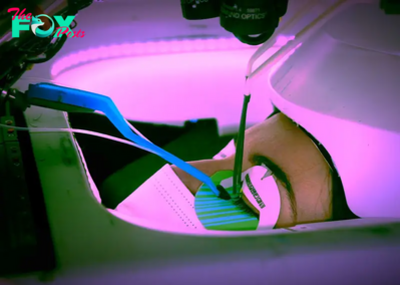Technology
AI-Generated Video of the Mona Lisa Rapping Sparks Strong Reactions From Viewers
The internet has reacted strongly to an artificial intelligence-generated video of the famous subject of Leonardo Da Vinci’s Mona Lisa painting singing along to a rap that actor Anne Hathaway wrote and performed.
The polarizing clip, which has elicited reactions online ranging from humor to horror, is one of the tricks of Microsoft’s new AI Technology called VASA-1. The Technology is able to generate lifelike talking faces of virtual characters using a single image and speech audio clip. The AI can make cartoon characters, photographs, and paintings sing or talk, as evidenced in footage Microsoft released as part of research published on April 16.
In the most viral clip, the woman in the Mona Lisa painting sings, her mouth, eyes and face moving, to “Paparazzi,” a rap Hathaway wrote and performed on Conan O’Brien’s talk show in 2011. In another Microsoft clip, an avatar sings, and in others generated from real photos, people speak on common-place topics.
The videos quickly gained traction online: One post on X, formerly Twitter, on April 18 featuring the singing Mona Lisa clip and others had garnered seven million views as of Sunday.
The online reactions were swift, strong and across the board. Some enjoyed the clips, with one commenter posting that the Mona Lisa video had them “rolling on (the) floor laughing.” Others were more wary or even disturbed. “This is wild, freaky, and creepy all at once,” one said. “Another day, another terrifying AI video,” another lamented. “Why does this need to exist? I can’t think of any positives,” one commenter criticized.
Microsoft’s researchers addressed the risks of the new Technology and said they have no plans to release an online demo or product “until we are certain that the Technology will be used responsibly and in accordance with proper regulations.”
“It is not intended to create content that is used to mislead or deceive,” the researchers wrote. “However, like other related content generation techniques, it could still potentially be misused for impersonating humans. We are opposed to any behavior to create misleading or harmful contents of real persons, and are interested in applying our technique for advancing forgery detection.”
“While acknowledging the possibility of misuse, it's imperative to recognize the substantial positive potential of our technique,” they said. “The benefits—such as enhancing Educational equity, improving accessibility for individuals with communication challenges, offering companionship or therapeutic support to those in need, among many others—underscore the importance of our research and other related explorations. We are dedicated to developing AI responsibly, with the goal of advancing human well-being.”
The latest development in AI comes as governments around the world are scrambling to regulate the new Technology and legislate against its criminal misuse.
One example is deepfake pornography, where the face of an individual is superimposed onto an explicit picture or video without their consent, an issue that even affected Taylor Swift earlier this year. In the U.S., while 10 states criminalize deepfakes, federal law does not, and multiple bills have been introduced in Congress to rectify this.
-

 Technology18h ago
Technology18h agoBreaking up Google? What a Chrome sell-off could mean for the digital world | The Express Tribune
-

 Technology1d ago
Technology1d agoAI harm is often behind the scenes and builds over time – a legal scholar explains how the law can adapt to respond
-

 Technology1d ago
Technology1d agoNewborn planet found orbiting young star, defying planet formation timeline | The Express Tribune
-

 Technology1d ago
Technology1d agoAwkwardness can hit in any social situation – here are a philosopher’s 5 strategies to navigate it with grace
-

 Technology1d ago
Technology1d agoNo need to overload your cranberry sauce with sugar this holiday season − a food scientist explains how to cook with fewer added sweeteners
-

 Technology1d ago
Technology1d agoTeslas are deadliest road vehicles despite safety features: study | The Express Tribune
-

 Technology2d ago
Technology2d agoUS pushes to break up Google, calls for Chrome sell-off in major antitrust move | The Express Tribune
-

 Technology2d ago
Technology2d agoPublic health surveillance, from social media to sewage, spots disease outbreaks early to stop them fast


























